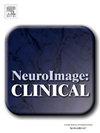Genetic and vascular risk factors for ischemic stroke and cortical morphometry in individuals without a history of stroke: A UK Biobank observational cohort study
IF 3.6
2区 医学
Q2 NEUROIMAGING
引用次数: 0
Abstract
Background
Stroke risk factors may contribute to cognitive decline and dementia by altering brain tissue integrity. If their effects on brain are nonnegligible, the target regions for stroke rehabilitation with brain stimulation identified by cross-sectional case-control studies may be biased due to the pre-existing brain differences caused by these risk factors. Here, we investigated the effects of stroke risk factors on cortical thickness (CT) and surface area (SA) in individuals without a history of stroke.
Methods
In this observational study, we used data from the UK Biobank cohort to explore the effects of polygenic risk score for ischemic stroke (PRSIS), systolic blood pressure (SBP), diastolic blood pressure (DBP), glycated hemoglobin (HbA1c), triglycerides (TG), and low-density lipoprotein (LDL) on CT and SA of 62 cerebral regions. We excluded non-Caucasian participants and participants with missing data, unqualified brain images, or a history of stroke or any other brain diseases. We constructed a multivariate linear regression model for each phenotype to simultaneously test the effect of each factor and interaction between factors. The results were verified by sensitivity analyses of SDP or DBP input and adjusting for body-mass index, high-density lipoprotein cholesterol, or smoking and alcohol intake. By excluding participants with abnormal blood pressure, glucose, or lipid, we tested whether vascular risk factor within normal range also affected cortical phenotypes. To determine clinical relevance of our findings, we also investigated the effects of stroke risk factors and cortical phenotypes on cognitive decline assessed by fluid intelligence score (FIQ) and the mediation of cortical phenotype for the association between stroke risk factor and FIQ.
Results
The study consisted of 27 120 eligible participants. Stroke risk factors were associated with 16 CT and two SA phenotypes in both main and sensitivity analyses (all p < 0.0004, Bonferroni corrected), which could explain portions of variances (partial R2, median 0.62 % [IQR 0.44–0.75 %] in main analyses) in these phenotypes. Among the 18 cortical phenotypes associated with stroke risk factors, we identified 26 specific predictor-phenotype associations (all p < 0.0026), including the positive associations between PRSIS and SA and between HbA1c and CT, negative associations of SBP and TG with CT, and mixed associations of PRSIS and DBP with CT. Neither LDL nor interactions between risk factors affected cortical phenotypes. Of the 16 associations between vascular risk factors and cortical phenotypes, ten were still significant after excluding participants with abnormal vascular risk assessments and diagnoses. Stroke risk factors were associated with FIQ in all analyses (p < 0.0004; partial R2, range 0.22–0.3 %), of which the associations of PRSIS and SBP with cognitive decline were mediated by CT phenotypes.
Conclusions
Stroke risk factors have substantial effects on cortical morphometry and cognitive decline in middle-aged and older people, which should be considered in the prevention of dementia and in the identification of target regions for stroke rehabilitation with brain stimulation.
无中风史者缺血性中风的遗传和血管风险因素以及皮质形态测量:英国生物库观察性队列研究
背景脑卒中风险因素可能通过改变脑组织的完整性导致认知功能下降和痴呆。如果这些因素对大脑的影响不可忽略,那么横断面病例对照研究确定的脑卒中脑刺激康复的目标区域可能会因为这些风险因素导致的已有脑差异而出现偏差。在此,我们研究了卒中风险因素对无卒中病史者大脑皮层厚度(CT)和表面积(SA)的影响。方法在这项观察性研究中,我们利用英国生物库队列的数据探讨了缺血性脑卒中多基因风险评分(PRSIS)、收缩压(SBP)、舒张压(DBP)、糖化血红蛋白(HbA1c)、甘油三酯(TG)和低密度脂蛋白(LDL)对 62 个脑区的 CT 和表面积的影响。我们排除了非白种人参与者和数据缺失、脑图像不合格或有中风或其他脑部疾病史的参与者。我们为每种表型构建了一个多变量线性回归模型,以同时检验每个因素的影响和因素间的交互作用。我们对 SDP 或 DBP 输入进行了敏感性分析,并对体重指数、高密度脂蛋白胆固醇或烟酒摄入量进行了调整,从而对结果进行了验证。通过排除血压、血糖或血脂异常的参与者,我们测试了正常范围内的血管风险因素是否也会影响大脑皮层表型。为了确定研究结果的临床相关性,我们还研究了卒中危险因素和大脑皮层表型对流体智力评分(FIQ)评估的认知能力下降的影响,以及大脑皮层表型对卒中危险因素和 FIQ 之间关联的中介作用。在主要分析和敏感性分析中,脑卒中危险因素与16种CT和2种SA表型相关(所有P均为0.0004,Bonferroni校正),这可以解释这些表型的部分差异(部分R2,主要分析中位数为0.62% [IQR 0.44-0.75%])。在与卒中风险因素相关的 18 种大脑皮层表型中,我们发现了 26 种特定的预测因子-表型关联(所有 p 均为 0.0026),包括 PRSIS 与 SA 之间以及 HbA1c 与 CT 之间的正相关、SBP 和 TG 与 CT 之间的负相关以及 PRSIS 和 DBP 与 CT 之间的混合关联。低密度脂蛋白和风险因素之间的相互作用均不影响大脑皮层表型。在血管风险因素与大脑皮层表型之间的 16 种关联中,有 10 种在排除了血管风险评估和诊断异常的参与者后仍具有显著性。在所有分析中,卒中风险因素都与FIQ相关(p < 0.0004; partial R2, range 0.22-0.3%),其中PRSIS和SBP与认知能力下降的关联是由CT表型介导的。
本文章由计算机程序翻译,如有差异,请以英文原文为准。
求助全文
约1分钟内获得全文
求助全文
来源期刊

Neuroimage-Clinical
NEUROIMAGING-
CiteScore
7.50
自引率
4.80%
发文量
368
审稿时长
52 days
期刊介绍:
NeuroImage: Clinical, a journal of diseases, disorders and syndromes involving the Nervous System, provides a vehicle for communicating important advances in the study of abnormal structure-function relationships of the human nervous system based on imaging.
The focus of NeuroImage: Clinical is on defining changes to the brain associated with primary neurologic and psychiatric diseases and disorders of the nervous system as well as behavioral syndromes and developmental conditions. The main criterion for judging papers is the extent of scientific advancement in the understanding of the pathophysiologic mechanisms of diseases and disorders, in identification of functional models that link clinical signs and symptoms with brain function and in the creation of image based tools applicable to a broad range of clinical needs including diagnosis, monitoring and tracking of illness, predicting therapeutic response and development of new treatments. Papers dealing with structure and function in animal models will also be considered if they reveal mechanisms that can be readily translated to human conditions.
 求助内容:
求助内容: 应助结果提醒方式:
应助结果提醒方式:


